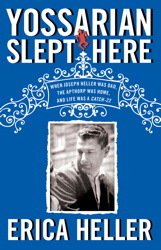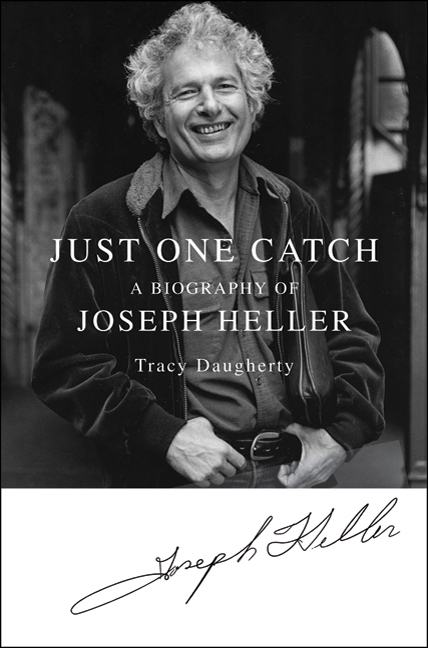Fifty-one years ago, nobody used the term “Catch-22” to describe a victim trapped in a contradictory, often bureaucratic, paradox. Not even Joseph Heller, who’d spent seven years writing his satirical World War II novel; he was still calling it “Catch-18.”
Then, just months before its publication, news that author Leon Uris had grabbed the numeral for “Mila 18” forced Heller and his editor to change the title. In 1961, Yossarian, Milo Minderbinder and Major Major met their public in “Catch-22.”
Few authors make a cultural impact as broad or as lasting as Heller did with “Catch-22.” But there was a catch: It was the 38-year-old writer’s first book, and he had a long life ahead of him; he died at 76 in 1999. He wrote other, possibly better books — he and many others thought his second novel, “Something Happened,” was his best — yet it’s “Catch-22” that lasts.
On the 50th anniversary of the publication of “Catch-22,” two new books remember Heller. An intimate view comes from daughter Erica Heller, who like her father writes with occasionally biting wit, in “Yossarian Slept Here.” Tracy Daugherty’s “Just One Catch” shows the path Heller took to become the man who wrote the novel and where he went from there.
Joseph Heller was born in Brooklyn to Russian Jewish immigrant parents in 1923 and brought up in the crowded ghetto of Coney Island. When he was 4, Heller was lavished with attention and gifts and enjoyed a rare party — unfortunately, the event was his father’s funeral.
If this early encounter with inverted logic (treats are for funerals!) helped form the dark-yet-giddy current of Heller’s writing, Daugherty doesn’t make such an explanatory leap. He’s assembled an appropriate amount of evidence for a biography, but he seems unsure what to do with it.
Heller’s own memoir, “Now and Then” (1998), provides much of the material Daugherty includes about Heller’s early life. He delivered telegraphs as a teenager, was sociable, handsome and mostly broke, and enlisted to fight in World War II.
Like his famous character Yossarian, Heller was a bombardier, flying in the glass nose of a B-25, and like Yossarian, the number of missions he had to fly kept creeping up. He flew 60 missions while stationed in Corsica from 1944 to 1945.
Upon his return, Heller’s half-brother coaxed him to take a short trip to the Catskills, where he met Shirley, his future wife, after being lassoed by her strong-willed mother. “I can only marvel at the pair of them now,” Erica Heller writes, “my grandmother and my father, both so cagey and indomitable.”
It’s these intimacies that make Heller’s book a vital read.
She portrays her father’s complexities with sympathy. Of his friendship, she writes, “the currency was frequently sarcasm — snarling, brutish yet often, impossibly, improbably, delightfully, and deliriously funny.”
Erica centers her narrative on the Apthorp, the Manhattan apartment building her parents moved into in 1952. At the time, her father was working as an ad man, and the building was a Gilded-Age island surrounded by unpleasant urban jetsam.
For years, Heller wrote in the odd hours at the dining table.
Daugherty is good at explaining the evolution of Heller’s writing career: how he found his devoted agent, Candida Donadio, who became legendary after Heller became a star. He also aptly portrays Heller’s friendships with lifelong buddies Mario Puzo, Mel Brooks and the artist Speed Vogel.
Daugherty mentions that Heller carried on affairs with women in his advertising circles before and after “Catch-22” was published, but they are little explored. Erica writes about her memories of her parents together as much as her father alone — they spent seemingly happy years in New York’s literary circles. She allows one significant dalliance — whom she dubs “Dr. Bugs” — to stand in for all of her father’s philandering.
Like the best memoirists, Erica reveals her own mistakes. When Shirley finally sought a divorce in the ’70s, she documented Heller’s affair with Dr. Bugs, showing this woman had traveled to the same places she and her husband did, sometimes staying in the same hotels. Joe insisted his estranged wife was paranoid, if not entirely insane, and Erica believed him.
Then in 1981, Heller fell ill with Guillain-Barre syndrome, a neurological disorder that put him in the hospital, paralyzed. Visiting one day, Erica pulled back the curtain and was astonished to find Dr. Bugs standing at her father’s bedside; she realized her mother was right, and her father had lied to her.
Heller’s life was changed by that illness. He settled into his house in East Hampton, and married his nurse. As time wore on, his cultural presence seemed less in demand. He wrote a sequel to “Catch-22,” 1994’s “Closing Time,” which few thought was a good idea.
Slipping from the cultural firmament was perhaps inevitable; Heller was as much a victim of changing times as he had earlier been the beneficiary.
When he began work on “Catch-18,” writing realistic novels about war was all the rage, but he wasn’t Norman Mailer or James Jones. By the time his novel was done, American culture and letters had changed, and Heller’s irreverence and irony found a place. “Catch-22” became an anti-establishment staple, part of a cultural revolution even a too-smart ad man with a wicked sense of humor couldn’t have predicted.
Send questions/comments to the editors.




Success. Please wait for the page to reload. If the page does not reload within 5 seconds, please refresh the page.
Enter your email and password to access comments.
Hi, to comment on stories you must . This profile is in addition to your subscription and website login.
Already have a commenting profile? .
Invalid username/password.
Please check your email to confirm and complete your registration.
Only subscribers are eligible to post comments. Please subscribe or login first for digital access. Here’s why.
Use the form below to reset your password. When you've submitted your account email, we will send an email with a reset code.